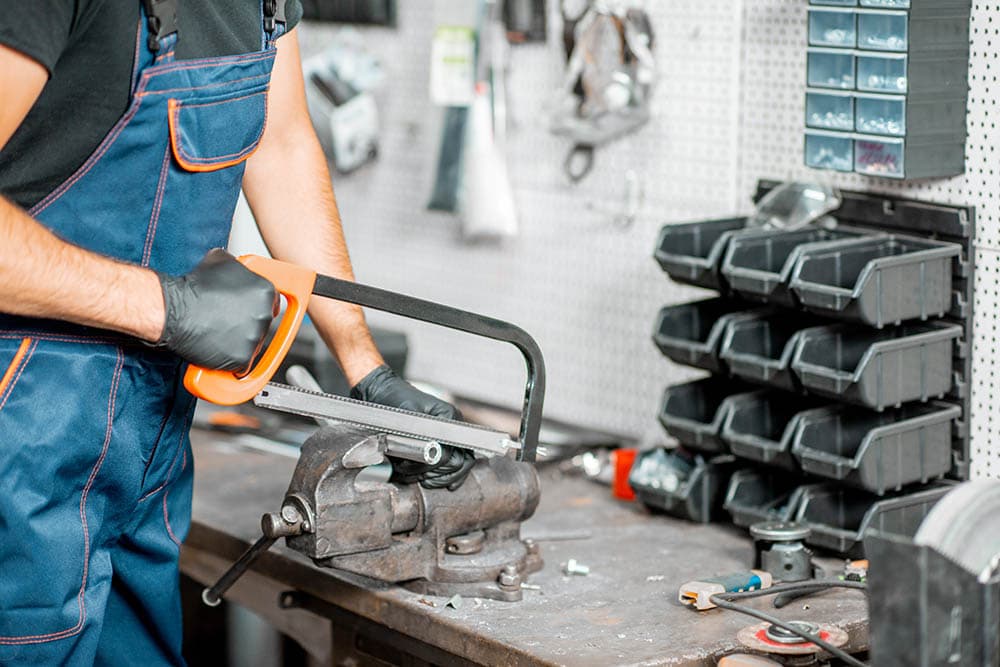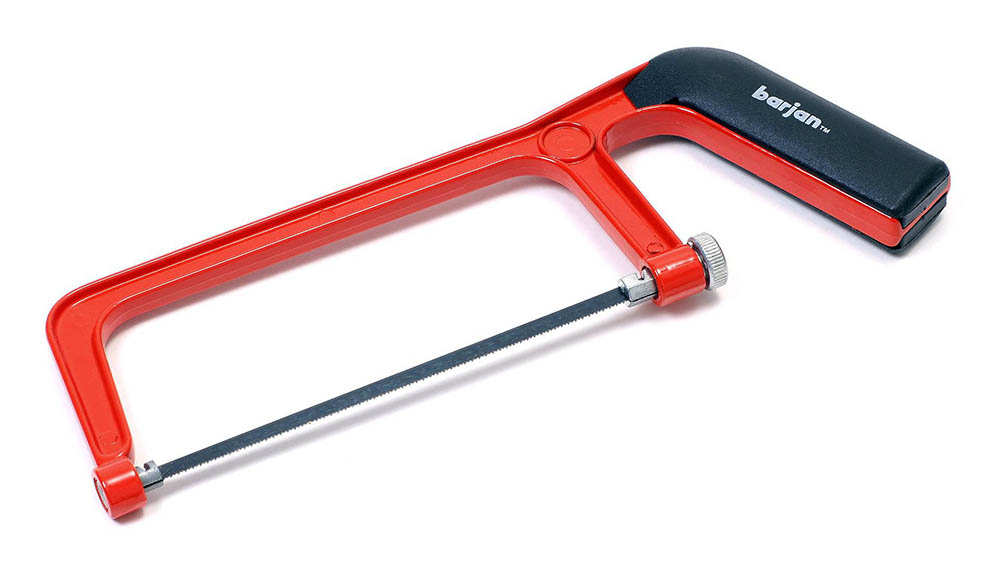What Is a Hacksaw? Types, Uses, Tips, & FAQ
-
Shea Cummings
- Last updated:

A hacksaw is a great tool for the DIYer kit. In addition, they are typically an everyday tool used by plumbers and electricians. When it comes time to cut metal, plastic, and other hard material, you’ll be happy you have a hacksaw.
The nice thing about these simple tools is they aren’t typically very expensive, and they don’t take up a lot of space. You can definitely get some “beefier” designed variations if you use it for work every day. Still, the average person doesn’t need a super heavy-duty hacksaw.
How Does it Work?
Most hacksaws consist of two components: the frame (including the handle) and a removable blade. The blade is attached and secured by tension. Usually, at the base of the handle where the blade attaches, there is a tensioner knob with which you can increase or decrease the tension.
One significant difference between a hacksaw and a regular hand saw is the orientation of the teeth. Quite often, hand saw teeth are curved backward so that the saw cuts on backward stroke. A hacksaw’s teeth are curved at a forward angle, so it cuts on the forward stroke.

What are the Different Types of Hacksaw?
Hand-held hacksaws come in varying sizes, from miniature to full-sized saws. All of them take various-sized blades; the main difference between them is the size of the frame and the way you hold the handle.
As a general rule, the better the quality, the more heavy-duty the frame will be. This is a significant consideration if it’s for everyday professional use. Besides that, the only real difference in saws is the blade length the frame allows. Common frame lengths are 6, 10, and 12-inches long.
One other option out there is a battery-powered hacksaw. These are quite expensive, and several brands such as DeWalt or Milwaukee make them.
Blade Types
The blade type is where the real difference between saws is. The primary factor separating blades is their tooth per inch (TPI) count. For example, a 10-inch hacksaw fits 10-inch blades. But those blades could have any number of TPI from 5 up to 32.
The lower the TPI, the bigger and more spaced out the teeth are. For a softer material like plastic or even some wood, you would use a 5 to 14 TPI blade. Hard metals like steel or iron you would use somewhere between 18 and 24 ideally. And if you’re cutting soft metal like aluminum, upwards of 32 is ideal for a nice finish on the cut.
Where is it Used?
The most common application for a hacksaw is metal and plastic. However, with a 5 to 14 TPI, you could cut some dry wood, but this still would not be the ideal tool for the job. Two trades that likely use hacksaws the most would be plumbers or electricians.
Here are some examples of materials that you can cut with a hacksaw:
- Steel pipe
- Threaded rod (sometimes called “Ready rod”)
- Electrical conduit pipe (aluminum or steel)
- Multi-conductor electrical cables
- Steel and aluminum struts
- PVC pipes

Advantages of Using a Hacksaw
Taking care of smaller cuts without needing to dig out a reciprocating saw (Sawzall) is a huge bonus of the hacksaw. And being reasonably compact, it doesn’t take up a lot of space in your bag.
Safety is another advantage of using a hacksaw versus another tool. As long as you wear suitable gloves and safety glasses, there’s not much that can go wrong.
Disadvantages of Using a Hacksaw
A hacksaw’s primary disadvantage is that it will not be ideal if you’re cutting large material. For example, if you have a 12-inch hacksaw, you’re limited to the material you can do a proper stroke on. Plus, a hacksaw lacks the oomph to get the job done for very hard and thick material.
If you’re running into situations like this, it may be a good idea to have a reciprocating saw handy.
Tips for Using a Hacksaw
Hacksaw use is pretty straightforward, but here are a couple of things to keep in mind for safety and overall effective use:
- Regular inspection: Like any tool, the components on your hacksaw wear out eventually. For example, the tensioner may wear out, which can be dangerous if the blade is not tight while cutting.
- Use a lubricant: The friction from using a hacksaw typically creates a lot of heat which can wreck the blade and material you’re cutting. So, using a good cutting lube is recommended.
- Keep blade tight: When cutting, you want to ensure that the blade is tight. And when you store it, loosen the blade to prolong its life.
- Directional cutting: Remember that a hacksaw cuts on the forward stroke. So apply even pressure going forward and lift up slightly when pulling it back.
Frequently Asked Questions (FAQs)
Can I cut wood with a hacksaw?
A hacksaw really isn’t designed for wood—there are better tools for that job. However, if you use a low TPI blade such as five or eight TPI, it will cut wood. Also, many bow saw blades will fit on a hacksaw, provided they are the right length. And bow saws are made for cutting wood.
What’s the best blade for a hacksaw?
It depends entirely on what you’re cutting. The one thing to remember is that more teeth will provide a smoother and nicer finish to the cut, but it will take longer to cut and will likely need more cleaning out. On the other hand, fewer teeth will cut faster and stay clean but will make a much rougher cut.
As a general rule: fewer teeth for softer material and more teeth for a harder material. Although, there are always exceptions to this rule. With experience, you’ll get a feel for the right blade for what you’re cutting.
Is there an alternative to a hacksaw that will cut the same things?
A reciprocating saw is a great option for a powered tool that will cut the same things as a hacksaw. The nice thing about these saws is that you can get blades to cut almost anything from steel to wood to blades that do both alright.
However, a reciprocating saw is much bulkier than a hacksaw and requires much more money, especially when you factor in batteries and chargers.
Conclusion
If you don’t use a hacksaw a lot, there’s no reason to spend a ton of money on one. However, when the need arises, they are a handy tool to have around. So, it’s worth buying at least a cheap one to keep in the garage.
Featured Image Credit: RossHelen, Shutterstock
Contents

